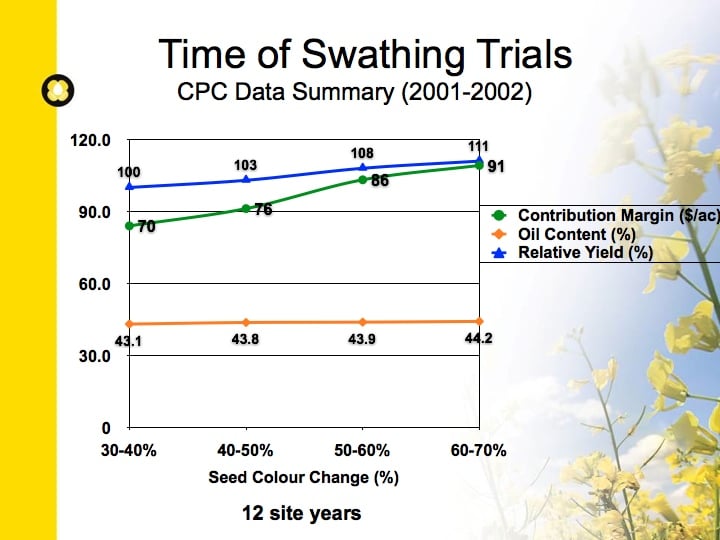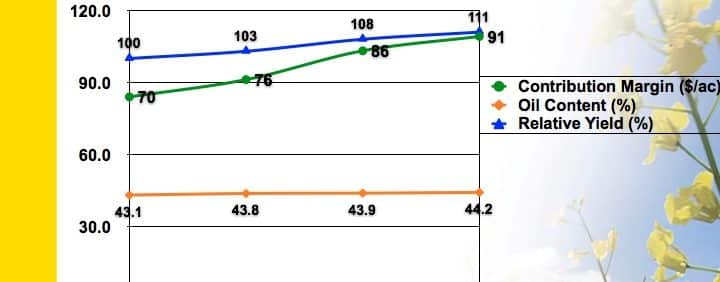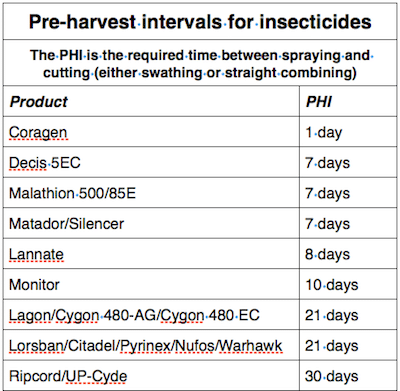
Research conducted by the Canola Council of Canada over approximately 28 site-years indicates that significant yield increases can be achieved by waiting until 50-60% seed colour change on the main stem before swathing. Swathing at 50-60% SCC resulted in 8% more yield than swathing at 30-40% SCC, 12% more yield than at 10-20% SCC, and 19% more yield than swathing before 10% SCC.
This is based on research from 2001 and 2002. With the lower seeding rates and branchier plants of today, this yield difference between SCC rates may be even greater. By cutting at 30-40% SCC on the mainstem, seeds in many of the side branches will be mushy. All these immature seeds will shrivel up and not contribute to yield. In short, cut too green and you cut a lot of green (as in money) off the bottom line.
Growers often face harvest challenges that make it difficult to swath all canola at 60% SCC. Here are some of those scenarios, with quick tips to help with the swath timing decision.
Logistics. With a lot of canola to swath, some fields have to be cut earlier. The best fields to start cutting before 60% seed colour change are the most uniform in maturity and with fewer side branches. CCC research shows that canola swathed at 30-40% SCC on the main stem yields about 8% less than canola swathed at 50-60% SCC. Avoid cutting any earlier than 30% SCC.
Lots of secondary branches. Fields with branchy canola or fields where the main raceme is missing a lot of pods may actually have most of their yield in side branches. In that case, base the 60% SCC assessment on the whole plant. Note, the main stem will be well beyond 60%. Swath timing for these fields becomes a balance between potential shelling on the main stem and waiting for final seeds on side branches to firm up.
Uneven crop. Hail earlier in the season or poor establishment from the start can cause various maturity levels in one field. “Determine which plants make up the bulk of the yield and make the decision based on them,” Brackenreed says. If half the plants are ready and half are just beginning SCC, consider waiting three or four days. Frost presents a minimal risk for riper parts of the field and later parts will see a huge benefit from these extra days if frost doesn’t occur.
Is frost forecast? A heavy frost will lock in high green counts unless the crop has adequate dry down time to achieve seed moisture of 20% or less. This often requires three good drying days — so swathing has to occur at least three days before the frost to achieve this benefit. If the crop is green, growers may want to take a chance that the frost will be light, knowing the crop needs more time to mature. Click here for more on this topic.
Has frost occurred? If plants are severely damaged, pods will often take on a white, wilted appearance. This is a sign that pods are desiccating, which will quickly lead to pod shatter and pod drop, especially with warm sunny afternoons. If pods are desiccating rapidly, swathing right away will preserve as much yield as possible. If pods do not appear to be severely damaged, then continue monitoring rather than swathing right away. Click here for more on this topic.
Hot days. With day time highs in the 30s or high 20s, wait for cooler days before swathing. Cutting canola in hot conditions will lead to rapid dry down and desiccation, which increases seed shrinkage — and leads to yield loss. If waiting isn’t an option, consider swathing at night to take advantage of cooler temperatures and any moisture from dew.
Late season hail. Pods damaged by hail have a higher potential for shattering as they dry. Swathing early to save these pods may not be worthwhile if these pods represent only a small percentage of the yield potential of the crop.
Late insecticide application. If insects are at economic thresholds and the crop is about a week from swathing, choose an insecticide with a pre-harvest interval of seven days or less. Applying an insecticide with a longer pre-harvest interval means you’ll have to wait that long to swath or straight combine. Do not apply insecticide to swathed canola.


